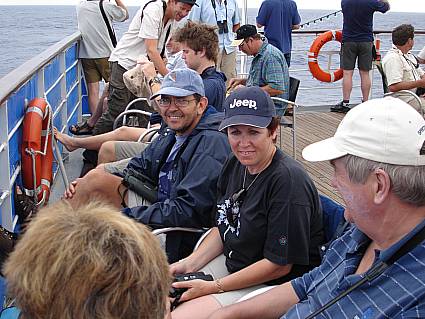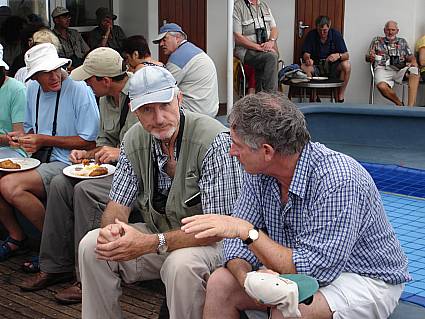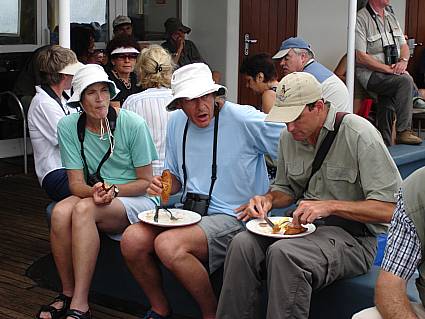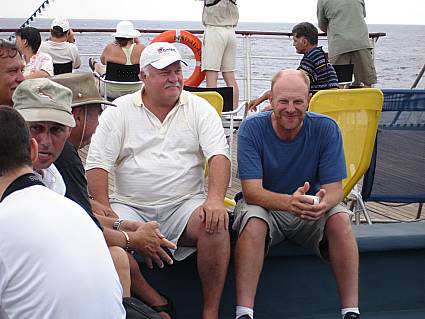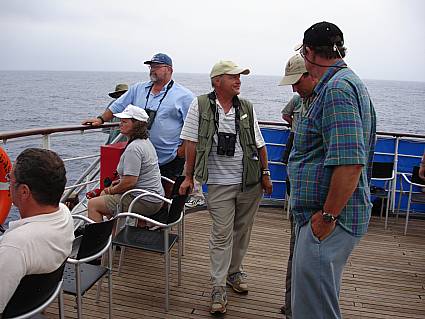
After a lot of red tape with delays with the harbour pilot and customs officials, the passengers boarded the ship and MV Madagascar eventually set sail at about 14h30.



As it got towards evening, the seas really started to “stand up” and the first night on board had many people feeling rather uncomfortable after somewhat over-indulging themselves at the buffet dinner!

Great-winged Petrel © Trevor Hardaker

During the course of this action, some minor distractions included another pod of Indo-Pacific Bottle-nosed Dolphins and a Hammerhead Shark. Eventually, some other seabirds started to make their appearance with the most notable being Arctic and Long-tailed Skuas, White-chinned Petrel, Wilson’s Storm Petrel and the first of our tropical targets, Sooty Tern. Shortly after this, we were treated to our first Red-tailed Tropicbirds of the trip and then, at about 15h00, there was a huge shout of excitement as a Red-footed Booby came in straight for the ship and landed on the rigging giving everyone on board the most amazing views. One could certainly tell by the vibe on board at the time that this was truly a special bird and very obviously a lifer for virtually all on board!!
Sooty Tern © Trevor Hardaker

Watching the Red-footed Booby on the rigging © Philip Coetzee
Red-footed Booby on the rigging © Trevor Hardaker
Several Red-tailed Tropicbirds put in an appearance and then the dipping started!! First off was a Tropical Shearwater which whizzed past the stern giving on a lucky few the opportunity to see it before it disappeared and then, just a short while later, Southern Africa’s 2nd Jouanin’s Petrel gave the birders on the bow the opportunity as it screamed past them. Needless to say, spirits were a little dampened after this as these were both particularly sought after species. What made it even worse was that an Oceanodroma storm petrel was also briefly glimpsed at this time, but could not be identified to species due to the short sighting.
A Pomarine Skua vaguely lifted the spirits as did a Ruddy Turnstone in the wake and then we were joined by a rather interesting falcon which flew up our wake and then, at low level, directly over the ship. Much discussion ensued over its identity and it was eventually agreed that it was a juvenile Sooty Falcon. It is certainly the first time that we have ever had the opportunity to discuss falcon identification on a pelagic trip!!!

Red-tailed Tropicbird © Trevor Hardaker

It was a little disappointing when it was announced that we were outside territorial waters eventually, but nevertheless, we kept our eyes peeled. Just a short distance (literally a few miles!!) outside the 200 mile limit, we passed over the Jaguar Seamount and things suddenly changed. We were greeted with large flocks of Sooty Terns and Red-footed Boobys, numbers of both Red-tailed and White-tailed Tropicbirds (including the beautiful golden morph) and what must rate as one of the most exciting experiences of the trip when a large flock of both Greater and Lesser Frigatebirds appeared out of nowhere and hung just metres above the ship! Eventually, we left the area and set course for Europa Island. We were now getting into the heat of the day and, as is typical for much tropical seabirding, we were faced with open birdless ocean for extended periods. In fact, at one point it was timed and 94 minutes elapsed between any sightings of birds!!! It certainly felt like an eternity!!
Male Greater Frigatebird © Trevor Hardaker


Greater Frigatebirds © Trevor Hardaker
Lesser Frigatebirds © Trevor Hardaker










After several hours, we closed in on Europa Island and birding immediately picked up. Large flocks of Sooty Terns abounded with the odd Bridled and Roseate Terns in amongst them and sometimes being chased by Arctic and Pomarine Skuas. We were also joined by large numbers of Red-footed Boobys and were given awesome views as they flew literally at arms length from us before suddenly swooping down and catching a flying fish. And if one needed a distraction, there were always the ever present Tropicbirds and Frigatebirds around. Added distractions were Short-finned Pilot Whales and Long-snouted Spinner Dolphins showing us their aerial antics whilst, close to the island, 2 Pied Crows were also seen. A small number of people were even lucky enough to glimpse a Green Turtle wallowing near the boat.
Due to the delay in leaving Durban, we were left with
less time than expected at the island and eventually had to leave on our
southward bound journey again. That evening much was celebrated and a lot
of damage was done to the bar stocks on board…



Immature Red-footed Booby © Trevor Hardaker
"Golden morph" White-tailed Tropicbird © Trevor Hardaker
Those who had not engaged too much in the liquid refreshments of the previous evening were up on deck at 04h30 again the next morning, when at 04h35 the shout of “small brown petrel” went out. Everyone on deck was on to the bird quickly and could not believe their luck when we were faced with another cracking Jouanin’s Petrel (the 3rd record for Southern Africa)!! With all the screaming and excitement on board, it obviously woke a lot of people up and the staircase from the cabins below on to the deck literally erupted with people with looks of horror on their face knowing that they had probably once again dipped. Unfortunately, the bird did not hang around long enough for all these people to see it.
The day continued on much the same vein as previous
days with good sightings of Sooty Tern, Greater Frigatebird,
both Tropicbirds and several reasonable sightings of Bridled
Tern. We were also joined at one point by a calling Common Whimbrel
that circled the ship a number of times before heading off.
As the day progressed, we were once again seeing good
numbers of Great-winged Petrels with Wilson’s Storm Petrel,
Pomarine Skua and some distant unidentifiable Phalaropes
also recorded. Other marine creatures included Broad-billed Swordfish,
Oceanic White-tipped Shark, Risso’s Dolphin and a small
pod of False Killer Whales, an animal that caused much excitement
on board.

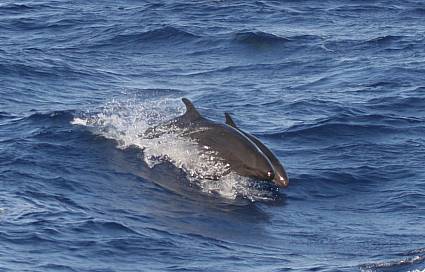
Common Whimbrel © Trevor Hardaker
False Killer Whales © Neil Gray
Late afternoon with everyone on board and, once again,
an Oceanodroma type storm petrel was picked up again flying low
over the water at a distance under a flock of Sooty Terns, but was
just too far to be identified with any certainty. Almost simultaneously,
everybody rushed to the opposite side of the boat as yet another Jouanin’s
Petrel was picked up. This time, there were a lot more people there to
see it, and as evening fell, celebrations picked up even bigger than the
previous night…
04h30 on our last day at sea and the decks were
extremely quiet. The early risers were greeted with the usual birds and a
male African Hoopoe also joined us for a short while. We enjoyed
our last few Sooty Terns and Red-tailed and White-tailed
Tropicbirds and were finally starting to realise that the trip was
coming to an end…
By just before 06h00, the decks had filled up with more chatting and coffee drinking than birding taking place when, suddenly, the screams of Barau’s Petrel erupted! The bird flew slowly down the port side of the ship affording everyone great views and then moved into the wake and stayed with the boat for probably about 6 or 7 minutes – it was certainly enough time to run downstairs and wake up some of the party animals and get them dressed and back up on deck to see the bird in time!! We could now officially call this trip a "mega trip"!!

Barau's Petrel © Trevor Hardaker
The rest of the day waned by comparison to this mega
with sightings of White-chinned Petrel and eventually, our first Shy
Albatross of the trip making their appearances as well as Striped
and Risso’s Dolphins.
Early morning on the 27th, we found ourselves just outside Durban harbour and were soon entering the harbour to dock whilst we ticked our last few species for the trip including an Arctic Skua.
